Colombia
 From Conservapedia
From Conservapedia | República de Colombia | |
|---|---|
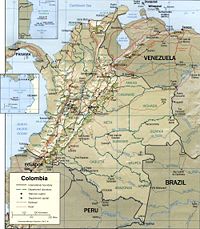 | |
 |
 |
| Flag | Coat of Arms |
| Capital | Bogota |
| Government | Constitutional Republic |
| Language | Spanish (official) |
| President | Gustavo Petro |
| Area | 440,831 sq. mi. |
| Population | 51,500,000 (2020) |
| GDP | $325,000,000,000 (2020) |
| GDP per capita | $6,311 (2020) |
| Currency | Peso |
The Republic of Colombia is a country just south of Panama, in the continent of South America. The primary language in Colombia is Spanish. The leftist, Gustavo Petro is the current President of Colombia.
Contents
- 1 People
- 2 Government
- 2.1 Foreign Relations
- 3 Defense
- 3.1 Narcotics and Terrorism
- 4 Economy
- 4.1 Industry and Agriculture
- 4.2 Trade
- 4.3 Mining and Energy
- 4.4 Foreign Investment
- 5 History
- 5.1 La Violencia and the National Front
- 5.2 Post-National Front Years
- 5.3 Pastrana Administration
- 5.4 Uribe Administration
- 5.5 Peace agreement with the FARC and Duque administration
- 6 See also
- 7 Further reading
- 7.1 Guidebooks
- 8 References
People[edit]
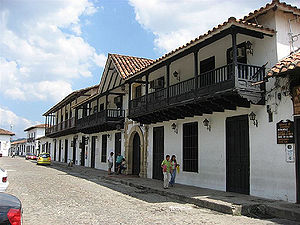
Colombia is the third-most populous country in Latin America, after Brazil and Mexico. Thirty cities have a population of 100,000 or more. The nine eastern lowlands departments, constituting about 54% of Colombia's area, have less than 3% of the population and a density of less than one person per square kilometer (two persons per sq. mi.). Ethnic diversity in Colombia is a result of the intermingling of indigenous peoples, Europeans and Africans. Today, only about 1% of the people can be identified as fully indigenous on the basis of language and customs.
Government[edit]
Under 1886 Constitution, executive, legislative, and judicial branches established with separation of powers and with checks and balances; nonetheless, executive retained strong policy-making authority. Chief executive is president of the republic, elected by direct popular vote for a four-year term and constitutionally probibited from seeking consecutive terms. Legislative authority vested in bicameral Congress consisting of 114-member Senate and 199-member House of Representatives. Congress popularly elected for four-year term. Judiciary consists of twenty-four-member Supreme Court; various district superior, circuit, municipal, and lower courts; and Council of State. In addition to national government, Colombia divided into twenty-three departments, four intendancies, and five commisaryships.

Foreign Relations[edit]
In 1969, Colombia, along with Bolivia, Chile, Ecuador and Peru, formed what is now the Andean Community. (Venezuela joined in 1973 and announced its departure in 2005; Chile left in 1976 and returned in 2006.) In the 1980s, Colombia broadened its bilateral and multilateral relations, joining the Contadora Group, the Group of Eight (now the Rio Group) and the Non-Aligned Movement, which it chaired from 1994 until September 1998. In addition, it has signed free trade agreements with Chile, Mexico and Venezuela. The U.S.-Colombia Free Trade Agreement was signed by President Bush in November 2006, and is awaiting congressional approval as of September 2007.
Colombia has traditionally played an active role in the United Nations and the Organization of American States and in their subsidiary agencies. Former President Gaviria became Secretary General of the Organization of American States (OAS) in September 1994 and was re-elected in 1999. Colombia has participated in all five Summits of the Americas, most recently in November 2005, and followed up on initiatives developed at the first two summits by hosting two post-summit, ministerial-level meetings on trade and science and technology. In March 2006, Bogota hosted the Sixth Regular Session of the Inter-American Committee against Terrorism.
U.S. policy toward Colombia supports the Colombian Government's efforts to strengthen its democratic institutions, promote respect for human rights and the rule of law, intensify counter-narcotics efforts, foster socioeconomic development, address immediate humanitarian needs, and end the threats to democracy posed by narcotics trafficking and terrorism. Promoting security, stability, and prosperity in Colombia will continue as long-term American interests in the region.
Defense[edit]
Colombia's Ministry of Defense is charged with the country's internal and external defense and security, and exercises jurisdiction over an army, navy—including marines and coast guard—air force, and national police under the leadership of a civilian Minister of Defense. Real spending on defense has increased every year since 2000, but especially so under President Uribe. Colombian spending on defense grew over 30% after inflation from 2001 to 2005, from $2.6 billion to more than 3.9 billion. Projected defense spending for 2006 was $4.48 billion. The security forces number about 350,000 uniformed personnel: 190,000 military and 160,000 police. President Uribe instituted a wealth tax in 2002, which raised over $800 million, with 70% used to increase 2002-2003 defense spending. A similar tax to be imposed from 2007 to 2011 is expected to raise up to $3.6 billion.
Many Colombian military personnel receive training in the United States or from U.S. instructors in Colombia. The United States provides equipment to the Colombian military and police through the military assistance program, foreign military sales and the international narcotics control program.
Narcotics and Terrorism[edit]
The U.S. Drug Enforcement Administration estimates that more than 80% of the worldwide powdered cocaine supply and as much as 90% of the powdered cocaine smuggled into the United States is produced in Colombia.
The Colombian Government is committed to the eradication of all illicit crops, interdiction of illegal drug shipments and financial controls to prevent money laundering. Between 2004 and 2006, Colombian security forces interdicted 562 metric tons of cocaine, coca base, and heroin. Coca cultivation decreased by 15% from 2001 to 2005, while opium poppy cultivation decreased by 68% from 2001 to 2004.
Terrorist groups in Colombia are actively engaged in narcotics production and trafficking. The FARC was believed responsible for more than half of the cocaine entering the United States.

Economy[edit]
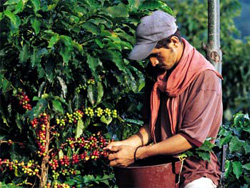
Colombia is a free market economy with major commercial and investment ties to the United States. Transition from a highly regulated economy has been underway for more than 15 years. In 1990, the administration of President Cesar Gaviria (1990–94) initiated economic liberalization or "apertura," with tariff reductions, financial deregulation, privatization of state-owned enterprises and adoption of a more liberal foreign exchange rate. These policies eased import restrictions and opened most sectors to foreign investment, although agricultural products remained protected.
Unlike many of its neighboring countries, Colombia has not suffered any dramatic economic collapses. The Uribe administration seeks to maintain prudent fiscal policies and has pursued tough economic reforms including tax, pension and budget reforms. A U.S. Agency for International Development (USAID) study shows that Colombian tax rates (both personal and corporate) are among the highest in Latin America. The unemployment rate in December 2006 was 11.4%, down from 15.1% in December 2002.
The sustained growth of the Colombian economy can be attributed to an increase in domestic security, the policies of keeping inflation low and maintaining a stable currency (the Colombian peso), petroleum price increases and an increase in exports to neighboring countries and the United States as a result of trade liberalization. The Andean Trade Preference and Drug Eradication Act (ATPDEA), which has been extended through February 2008, also plays a pivotal role in Colombia's economic growth. Signing a free trade agreement in November 2006 portends further opportunity for growth once it is approved by the legislatures of both countries and implemented.
Industry and Agriculture[edit]
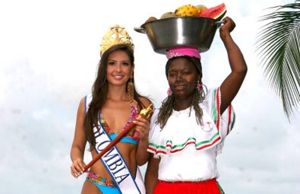
The most industrially diverse member of the five-nation Andean Community, Colombia has five major industrial centers—Bogota, Medellin, Cali, Bucaramanga and Barranquilla—each located in a distinct geographical region. Colombia's industries include textiles and clothing, leather products, processed foods and beverages, paper and paper products, chemicals and petrochemicals, cement, construction, iron and steel products and metalworking.
Colombia's diverse climate and topography permit the cultivation of a wide variety of crops. In addition, all regions yield forest products, ranging from tropical hardwoods in the lowlands, to pine and eucalyptus in the colder areas. Cacao, sugarcane, coconuts, bananas, plantains, rice, cotton, tobacco, cassava and most of the nation's beef cattle are produced in the hot regions from sea level to 1,000 meters elevation. The temperate regions—between 1,000 and 2,000 meters—are better suited for coffee, flowers, corn and other vegetables, pears, pineapples, and tomatoes. The cooler elevations—between 2,000 and 3,000 meters—produce wheat, barley, potatoes, cold-climate vegetables, flowers, dairy cattle and poultry.
Trade[edit]
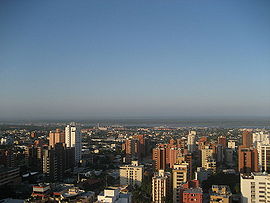
In 2006, Colombia was the United States' fifth-largest export market in the Western Hemisphere behind Canada, Mexico, Brazil, and Venezuela and the largest agricultural export market in the hemisphere after the North American Free Trade Agreement (NAFTA) countries. U.S. exports to Colombia in 2006 were $6.9 billion, up 13.2% from the previous year. U.S. imports from Colombia were $9.6 billion, up 4%. Colombia's major exports are petroleum, coffee, coal, nickel, and nontraditional exports (e.g., cut flowers, gold, bananas, semiprecious stones, sugar, and tropical fruits). The United States is Colombia's largest trading partner, representing about 40% of Colombia's exports and 26.6% of its imports.
Colombia has improved protection of intellectual property rights through the adoption of three Andean Pact decisions in 1993 and 1994 as well as an internal decree on data protection. The United States remains concerned over deficiencies in licensing and copyright protection.
Mining and Energy[edit]
Colombia has considerable mineral and energy resources, especially coal and natural gas reserves. New security measures and increased drilling activity have slowed the drop in petroleum production, allowing Colombia to continue to export through 2010 or 2011, given current production estimates. In 2006, gas reserves totaled 7,349 billion cubic feet. Gas production totaled 680 million cubic feet per day. The country's current refining capacity is 299,200 barrels per day. Mining and energy related investments have grown because of higher oil prices, increased demand and improved output. Colombia has significantly liberalized its petroleum sector, leading to an increase in exploration and production contracts from both large and small hydrocarbon industries.
Colombia is presently the 16th-greatest coal producing country, accounting for about 1% of the world's total annual coal production, and the largest producer in Latin America (65.8 million tons in 2006). Colombia has proven recoverable coal reserves of about 7.4 billion short tons, the majority of which are located in the north of the country. Ferronickel production decreased from 116 million pounds in 2005 to 112.7 million pounds in 2006. Colombia historically has been the world's leading producer of emeralds, although production has fallen in recent years. Emerald production fell from 116.3 million carats in 2005 to 112.7 million carats in 2006. Colombia is also a significant producer of gold, silver, and platinum.
Foreign Investment[edit]
The United States is the largest source of new foreign direct investment (FDI) in Colombia, particularly in the areas of coal and petroleum. In 2006, new FDI totaled $6.3 billion, an increase of 294% from 2002. The bulk of the new investment is in the manufacturing, mining, and petroleum sectors. The only activities closed to foreign direct investment are defense and national security, and disposal of hazardous wastes. Capital controls have been implemented to reduce currency speculation and to keep foreign investment in-country for at least a year. In order to encourage investment in Colombia, Congress approved a law in 2005 to protect FDI.
History[edit]

During the pre-Columbian period, the area now known as Colombia was inhabited by indigenous societies situated at different stages of socio-economic development, ranging from hunters and nomadic farmers to the highly structured Chibchas, who are considered to be one of the most developed indigenous groups in South America.
Santa Marta was the first permanent Spanish settlement founded in 1525. Santa Fe de Bogota was founded in 1538 and, in 1717, became the capital of the Viceroyalty of New Granada, which included what are now Venezuela, Ecuador, and Panama. Bogota was one of three principal administrative centers of the Spanish possessions in the New World.
On July 20, 1810, the citizens of Bogota created the first representative council to defy Spanish authority. Full independence was proclaimed in 1813, and in 1819 the Republic of Greater Colombia was formed to include all the territory of the former Viceroyalty (Colombia, Venezuela, Ecuador and Panama). Simon Bolivar was elected its first president with Francisco de Paula Santander as vice president. Conflicts between followers of Bolivar and Santander led to the formation of two political parties that have since dominated Colombian politics. Bolivar's supporters, who later formed the nucleus of the Conservative Party, sought strong centralized government, alliance with the Roman Catholic Church and a limited franchise. Santander's followers, forerunners of the Liberals, wanted a decentralized government, state control over education and other civil matters, and a broader suffrage.
Throughout the 19th and early 20th centuries, each party held the presidency for roughly equal periods of time. Colombia maintained a tradition of civilian government and regular, free, elections. Notwithstanding the country's commitment to democratic institutions, Colombia's history also has been characterized by widespread, violent conflict. Two civil wars resulted from bitter rivalry between the Conservative and Liberal parties: The War of a Thousand Days (1899-1903) claimed an estimated 100,000 lives and La Violencia (the Violence) (1946-1957) claimed about 300,000 lives.
La Violencia and the National Front[edit]
The assassination of Liberal leader Jorge Eliecer Gaitan in 1948 sparked the bloody conflict known as La Violencia. Conservative Party leader Laureano Gomez came to power in 1950, but was ousted by a military coup led by General Gustavo Rojas Pinilla in 1953. When Rojas failed to restore democratic rule and became implicated in corrupt schemes, he was overthrown by the military with the support of the Liberal and Conservative Parties.
In July 1957, an alliance between former Conservative President Laureano Gomez (1950–53) and former Liberal President Alberto Lleras Camargo (1945–46) led to the creation of the National Front. It established a power-sharing agreement between the two parties and brought an end to "La Violencia." The presidency would be determined by regular elections every 4 years and the two parties would have parity in all other elective and appointive offices. This system was phased out by 1978.
Post-National Front Years[edit]
During the post-National Front years, the Colombian Government made efforts to negotiate a peace with the persistent guerrilla organizations that flourished in Colombia's remote and undeveloped rural areas. In 1984, President Belisario Betancur, a Conservative, negotiated a cease-fire with the Revolutionary Armed Forces of Colombia (FARC) and the Democratic Alliance/M-19 (M-19) that included the release of many imprisoned guerrillas. The National Liberation Army (ELN) rejected the government's cease fire proposal at that time. The M-19 pulled out of the cease-fire when it resumed fighting in 1985. The army suppressed an M-19 attack on the Palace of Justice in Bogota in November 1985, during which 115 people were killed, including 11 Supreme Court justices. The government and the M-19 renewed their truce in March 1989, which led to a peace agreement and the M-19's reintegration into society and political life. The M-19 was one of the parties that participated in the process to enact a new constitution (see below), which took effect in 1991. The FARC ended the truce in 1990 after some 2,000-3,000 of its members who had demobilized had been murdered.
A new constitution in 1991 brought about major reforms to Colombia's political institutions. While the new constitution preserved a presidential, three-branch system of government, it created new institutions such as the Inspector General, a Human Rights Ombudsman, a Constitutional Court and a Superior Judicial Council. The new constitution also reestablished the position of Vice President. Other significant constitutional reforms provide for civil divorce, dual nationality and the establishment of a legal mechanism ("tutela") that allows individuals to appeal government decisions affecting their constitutional rights. The constitution also authorized the introduction of an accusatory system of criminal justice that is gradually being instituted throughout the country, replacing the previous written inquisitorial system. A constitutional amendment approved in 2005 allows the president to hold office for two consecutive 4-year terms.
Colombian governments have had to contend with the combined terrorist activities of left-wing guerrillas, the rise of paramilitary forces in the 1990s and the drug cartels. Narco-terrorists assassinated three presidential candidates during the election campaign of 1990. After Colombian security forces killed Medellin cartel leader Pablo Escobar in December 1993, indiscriminate acts of violence associated with his organization abated as the "cartels" were broken into multiple and smaller trafficking organizations that competed against each other in the drug trade. Guerrillas and paramilitary groups also entered into drug trafficking as a way to finance their military operations.
Pastrana Administration[edit]
The administration of Andres Pastrana (1998-2002), a Conservative, faced increased countrywide attacks by the FARC and ELN, widespread drug production and the expansion of paramilitary groups. The Pastrana administration unveiled its "Plan Colombia" in 1999 as a strategy to deal with these longstanding problems, and sought support from the international community. Plan Colombia is a comprehensive program to combat narco-terrorism; spur economic recovery; strengthen democratic institutions and respect for human rights; and provide humanitarian assistance to internally displaced persons.
In November 1998, Pastrana ceded a sparsely populated area the size of Switzerland in south-central Colombia to the FARC's control to serve as a neutral zone where peace negotiations could take place. The FARC negotiated with the government only fitfully while continuing to mount attacks and expand coca production, seriously undermining the government's efforts to reach an agreement. Negotiations with the rebels in 2000 and 2001 were marred by rebel attacks, kidnappings and fighting between rebels and paramilitaries for control of coca-growing areas in Colombia. In February 2002, after the FARC hijacked a commercial aircraft and kidnapped a senator, Pastrana ordered the military to attack rebel positions and reassert control over the neutral zone. FARC withdrew into the jungle and increased attacks against Colombia's infrastructure, while avoiding large-scale direct conflicts with the military.
Uribe Administration[edit]
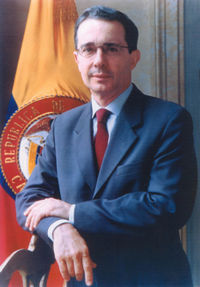
Álvaro Uribe, an independent, was elected president in May 2002 on a platform to restore security to the country. Among his promises was to continue to pursue the broad goals of Plan Colombia within the framework of a long-term security strategy. In the fall of 2002, Uribe released a national security strategy that employed political, economic and military means to weaken all illegal narco-terrorist groups. The Uribe government offered to negotiate a peace agreement with these groups with the condition that they agree to a unilateral cease-fire and to end drug trafficking and kidnapping.
In December 2003, the Colombian Self-Defense Forces (AUC) paramilitary group entered into a peace agreement with the government that has led to the collective demobilization of over 31,000 AUC members. In addition, over 10,000 members of the AUC and other illegal armed groups have individually surrendered their arms. In July 2005, President Uribe signed the Justice and Peace Law, which provides reduced punishments for the demobilized if they renounce violence and return illegal assets, which are to provide reparations to victims.
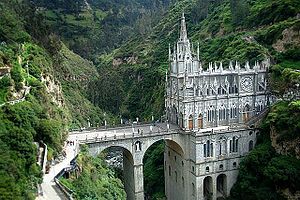
The ELN and the government began a round of talks with the Colombian Government mediated by the Mexican Government in mid-2004. The ELN withdrew from the talks after the Mexican Government voted to condemn Cuba's human rights record at the United Nations in April 2005. In December 2005, the ELN began a new round of talks with the Colombian Government in Cuba that led to two more meetings, the latest one being held in July 2007. The dialogue is expected to continue.
As a result of the government's military and police operations, the strength of the FARC has been reduced in major areas. Since 2000, the FARC has not carried out large scale multi-front attacks, although it has mounted some operations that indicate it has not yet been broken. The FARC has rejected several government proposals aimed at bringing about an exchange of some 45 hostages. Three American citizens, who were working on counternarcotics programs, were captured by the FARC in February 2003. Their safe return is a priority goal of the United States and Colombia.
Colombia maintains an excellent extradition relationship with the United States. The Uribe administration has extradited more than 500 fugitives to the United States. Among those extradited in 2005 were Cali Cartel leaders Gilberto Rodriguez Orejuela and his brother Miguel, and FARC leaders Juvenal Ovidio Palmera Pineda (aka "Simon Trinidad") and Omaira Rojas Cabrera (aka "Sonia").
In 2004, the Uribe government established, for the first time in recent Colombian history, a government presence in all of the country's 1,099 municipalities (county seats). Attacks conducted by illegally armed groups against rural towns decreased by 91% from 2002 to 2005. Between 2002 and 2006, Colombia saw a decrease in homicides by 37%, kidnappings by 78%, terrorist attacks by 63%, and attacks on the country's infrastructure by 60%.
Although much attention has been focused on the security aspects of Colombia's situation, the Uribe government also is making significant efforts on issues such as expanding international trade, supporting alternate means of development, and reforming Colombia's judicial system.
President Uribe was reelected with 62% of the vote in May 2006. In congressional elections in March 2006, the three leading pro-Uribe parties (National Unity, Conservative Party, and Radical Change) won clear majorities in both houses of Congress. In late 2006, the Supreme Court began investigations and ordered the arrest of some members of Congress for actions on behalf of paramilitary groups.
In January 2007, Colombian leaders presented a new strategy to consolidate and build on progress under Plan Colombia, called the "Strategy to Strengthen Democracy and Social Development." The new strategy continues successful Plan Colombia programs while increasing state presence by improving access to social services, and supporting economic development through sustainable growth and trade.
Peace agreement with the FARC and Duque administration[edit]
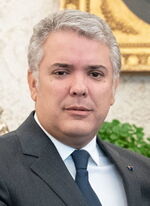
The Colombian government from Juan Manuel Santos approved a peace accord with the Revolutionary Armed Forces of Colombia (FARC) in 2016.[1] However, voters narrowly rejected the peace deal in a referendum, as there were worries that the deal was far too lenient towards the FARC.[2] In November 2016, the Colombian government approved a revised treaty with FARC, changed to address some, but not all, of the concerns of conservatives.[3] This time, the treaty was not brought before the voters, but rather the Colombian Congress.[3] It was reported in April 2017 that FARC continued to possess weapons despite the deal that was made.[4] It was reported in mid-May that FARC members continued to engage in violence and kidnappings.[5] FARC continued to exist, but at a political party.[6] By April 2018, the peace agreement was failing, and violence and cocaine production had sharply risen.[7]
On September 4, 2017, Colombia signed a ceasefire deal with its last remaining guerrilla organization, the National Liberation Army.[8]
In the 2018 presidential election, conservative Iván Duque, a critic of the FARC agreement, was elected Colombia's president, defeating a leftist former guerrilla terrorist.[9] Duque was sworn in on August 7, 2018.[10]
By August 2019, the peace agreement had broken down.[11][12]
In 2021 a marxist insurrection took place during Duque's government.
In the 2022 Presidencial Election the engineer Rodolfo Hernández lost to the leftist Gustavo Petro in the second round. Since 2015 Presidents can't be reelected.
See also[edit]
- Gallery of South-American painting
Main source:
| Copyright Details | |
|---|---|
| License: | This work is in the Public Domain in the United States because it is a work of the United States Federal Government under the terms of Title 17, Chapter 1, Section 105 of the U.S. Code |
| Source: | File available from the United States Federal Government. |
Further reading[edit]
Guidebooks[edit]
- Colombia by Jens Porup (2009) excerpt and text search
- Colombia Handbook Tread Your Own Path Travel Guides, by Charlie Devereux (3rd ed. 2009) excerpt and text search
- Colombia (Bradt Travel Guide) by Sarah Woods (2008) excerpt and text search
- VIVA Travel Guides Colombia by Lorraine Caputo, Paula Newton, and Richard McColl (2009) excerpt and text search
References[edit]
- ↑ Karl, Robert (October 1, 2016). Here’s the century-long history behind Colombia’s peace agreement with the FARC. The Washington Post. Retrieved October 1, 2016.
- ↑ Murphy, Helen & Cobb, Julia Symmes (October 3, 2016). Colombia's peace deal in limbo after shock referendum. Reuters. Retrieved October 4, 2016.
- ↑ 3.0 3.1 Casey, Nicholas (November 24, 2016). Colombia and FARC Sign New Peace Deal, This Time Skipping Voters. The New York Times. Retrieved November 26, 2016.
- ↑ Arostegui, Martin (April 20, 2017). Colombia's FARC concealing weapons despite deal, intelligence analysts say. Fox News. Retrieved April 20, 2017.
- ↑ Martel, Frances (May 15, 2017). Colombia: FARC Terrorists Abduct Ranchers, UN Employee as Peace Deal Kicks In. Breitbart News. Retrieved May 16, 2017.
- ↑ Bocanegra, Nelson; Cobb, Julia Symmes (August 27, 2017). After decades of war, Colombia's FARC rebels debut political party. Reuters. Retrieved December 25, 2017.
- ↑ Arostegui, Martin (May 3, 2018). Cracks in the FARC peace deal: Violence, cocaine production surge in Colombia. The Washington Times. Retrieved May 4, 2018.
- ↑ Colombia signs cease-fire deal with last guerrilla group. Fox News (from the Associated Press). Retrieved September 4, 2017.
- ↑ Multiple references:
- Martel, Frances (June 18, 2018). Martel: Colombia’s Conservative Heartland Saves Another Election Day. Breitbart News. Retrieved June 18, 2018.
- Boylan, Dave (June 17, 2018). Ivan Duque wins Colombia's presidential race. The Washington Times. Retrieved June 18, 2018.
- Arostegui, Martin (May 31, 2018). Hard-line conservative candidate in Colombia taps fear of Venezuelan-style collapse to win votes. The Washington Times. Retrieved September 24, 2018.
- ↑ Murphy, Helen; Cobb, Julia Symmes (August 7, 2018). Duque becomes Colombia's president, promising to unite divided nation. Breitbart News. Retrieved August 7, 2018.
- ↑ Taylor, Luke (August 11, 2019). Colombia’s Warring Gangs Target Migrants at Venezuelan Border; Peace Process Stutters. The Epoch Times. Retrieved August 11, 2019.
- ↑ Thousands forced to flee as rights group warns of 'war' in Colombia border area. The Guardian (from the Associated Press). August 8, 2019. Retrieved August 11, 2019.
| |||||
Categories: [South American Countries] [Colombia] [Spanish Empire] [Christian-Majority Countries]
↧ Download as ZWI file | Last modified: 02/25/2023 19:37:21 | 121 views
☰ Source: https://www.conservapedia.com/Colombia | License: CC BY-SA 3.0
 ZWI signed:
ZWI signed: KSF
KSF